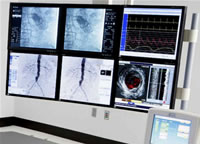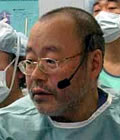|
Intravascular
Ultrasound (IVUS) Use Growing with Integration into Routine
Cath Lab Imaging
|
 |
May 15, 2008 -- Intravascular
Ultrasound, or IVUS (pronounced "eye-viz") is an imaging
technology that looks at arteries from the inside out.
Invented
two decades ago, IVUS recently has been gaining in usage due
to safety concerns about stent thrombosis: cardiologists who use
the technology feel that IVUS guidance adds a measure of precision
for proper stent placement and expansion during angioplasty.
A second reason the use of IVUS is on the rise
is that the technology has been made easier to use.
IVUS
consists
of a
tiny ultrasound imaging device, mounted on a catheter
that can be threaded across a section
of artery to yield both a cross-sectional and longitudinal
view, showing the amount and shape of plaque
and whether or not a stent is has been optimally deployed
and expanded -- information that is not shown by standard angiography.

Volcano
s5i Integrated Console Displays Both IVUS and Angiographic
Images |
|
The first generations of intravascular
ultrasound equipment consisted of a separate console that had
to be wheeled out and booted up
to use. The result was that the equipment very often sat on the
sidelines.
However, today's IVUS can be integrated into the primary
catheterization lab imaging console. For example, Volcano Corporation
(Nasdaq: VOLC), one of only two U.S. manufacturers of IVUS
systems, has partnered with all four major cath lab suppliers,
GE, Philips, Siemens
and Toshiba, and yesterday Volcano announced the 1,000th worldwide
installation of its s5 and s5i integrated imaging consoles. |
As evidence of this recent increase in adoption,
Volcano has posted sales gains of 25-35% for the past two quarters.
And increasingly IVUS is being utilized in centers that have strong fellowship
programs, training future interventionalists. At one such center,
the Dartmouth-Hitchcock
Medical Center in New Hampshire, the Director of the Cardiovascular
Catheterization Laboratory, Dr.
Craig A. Thompson, explains the importance of
IVUS integration:
"I think the current generation
IVUS integrated table side systems really
streamline
the process
in terms of maintaining cath lab case and turnover efficiency,
and frankly, their edge detection and imaging chain algorithms
are becoming simpler to use, so that some of the historic barriers
to being able to use IVUS efficiently and interpret the images
and use that to possibly modify the intervention are improving.
"I think just the simple integration of IVUS systems
at bedside is a huge benefit. It is tremendous! I think it’s
something that just cannot be adequately captured -- this is
incredibly beneficial. Because of that and the recurrent emphasis
on having very good technique in stent deployment and device
utilization, I think IVUS is going to have a resurgence." |
|

Dr. Craig
A. Thompson, Dartmouth-Hitchcock
Medical Center |
For many years, intravascular ultrasound has been
used as a research tool. Its ability to measure precisely both the
thickness and distribution of intracoronary plaque has mandated its
use as part of many clinical trials -- judging not only the efficacy
of drug-eluting stents, but also various pharmaceuticals, such as
statins, and whether or not they can stop or even reduce plaque.
Two recent drug-eluting stent trials, for Medtronic's
Endeavor and Abbott's XIENCE, both have had positive
results,
but an interesting sidelight is that in
trials for both stents, the Japanese arms showed significantly
better outcomes in terms of "late loss", a measure of how
much tissue has regrown inside the stent.

Dr. Shigeru
Saito of Kamakura, Japan during live course |
|
Angioplasty.Org asked Dr.
Shigeru Saito, the principal investigator of the Japanese studies
for
both clinical trials, why that might be. He replied simply, "IVUS
-- in Japan IVUS is reimbursed so we use IVUS much more." Dr
Saito, who is Director of Cardiology and Catheterization Laboratories,
Shonan Kamakura General Hospital, explained how IVUS showed that
sometimes the stent required further expansion:
"Before using IVUS,
we were very happy just looking at the cine [angiography].
But after doing IVUS, we were not happy because the stent was
not
fully
expanded.The most important
thing about using IVUS is that we can exactly see whether the
stent is fully expanded or not -- and the second thing: is
the stent is fully apposed to the vessel wall? It's very important
in terms of the long term stent thrombosis." |
One of the ongoing challenges for the wider
dissemination of IVUS has been to make the standard of care that
is present in highly monitored
clinical
trials
available
to practitioners and their patients on a daily basis. It is in this
area that the integrated and easier-to-use intravascular ultrasound
technology
has been
making inroads. Dr. Michael C. Foster, MD,
of the South Carolina Heart Center, told Angioplasty.Org how that
has been working in his lab:
"If we use an integrated
system, there really is no significant increase in the procedure
time, and you’re not adding the personnel costs.... There’s
no bringing in a machine, turning it on, waiting for the computer
to boot up, and
then a technician adding the name, the age, birth date, none of that has to be
done....
"I would call it a plug-and-play environment, and you
instantaneously have your pictures. In about one minute, I
can get the IVUS set and do a pull-back
into the artery that I'm interested in. And, of course, I’m looking at the images
as I'm pulling back, and I'll usually spend another minute or two, on an interesting
case, manipulating images, maybe making some measurements, and so forth. So from
soup to nuts, we’re talking about three minutes to do IVUS." |
|

Dr. Michael
Foster, South Carolina
Heart Center |
Proponents of IVUS, as well as other new imaging
technologies, feel that these tools have an important role in patient
safety and in improving procedural outcomes -- even in the era of
second generation drug-eluting stents.
As former President of the
Society for Cardiac Angiography and Interventions
(SCAI), John
McBarron Hodgson, MD, told Angioplasty.Org:

John
Hodgson, MD
Phoenix, Arizona |
|
"I don't
care if you've got a balloon, a cutter, a zapper, a laser,
whatever...whether you want to call the stent
a XIENCE, or put it on a Vision, it doesn't make any difference.
You
still have to make sure that you've got a good opening, and
the only
way that you can do that effectively is with IVUS.
So, I don't care what they develop in the future -- we need
a way to ensure that we have mechanically opened that vessel
in the best way possible,
and it depends on the plaque distribution, the plaque burden,
the plaque calcification, etc., and the only way you can
reliably look at that is with intravascular ultrasound. |
reported by Burt Cohen, Angioplasty,Org, originally
published May 13, 2008 / updated May 15, 2008
|






